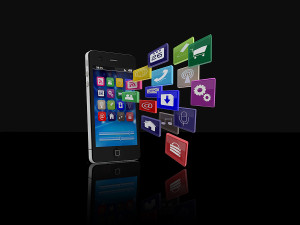OctoberNews
Blogging Company News Email Florida Living Mobile NewsMobile Marketing – Just How Big Is It?
Mobile marketing is the future right? Well that’s what people are saying anyway based on the growing stats. But just how likely is it that we all go mobile?
 I thought a good exercise in the practicality of mobile marketing would be to write this article on my phone. You see, mobile use will be limited by what you can do on a mobile device. Human nature dictates that people will only do what they see the need to do. That can help or hurt mobile use, which will in turn help or hurt mobile marketing.
I thought a good exercise in the practicality of mobile marketing would be to write this article on my phone. You see, mobile use will be limited by what you can do on a mobile device. Human nature dictates that people will only do what they see the need to do. That can help or hurt mobile use, which will in turn help or hurt mobile marketing.
Let’s first look at what mobile marketing consists of. In my mind, mobile marketing includes any method of touching someone while they are using their mobile device. I am not including calls or texts, but apps, and browsing – the newer non-traditional methods of marketing.
We know that mobile use is growing by leaps and bounds, and why not? Back to the human law that people will only change when they see the need to change. If you are already on a desktop working on a spread sheet and want to know what movies are playing tonight, you are not likely to reach for your phone unless you think it will be easier to complete your search there. From a marketing perspective, we have to embrace this concept. People are not going to use your app just because you built it, it has to make life easier for them.
I believe that most of the growth we have seen in the mobile market is based on what you can do while you are in transit or already “phone in hand”. We haven’t really seen people choosing to use their mobile device to search because it’s easier. They use what they are already using.
So, now we have two questions:
1. If people are going to use what they are already using, how do we make them want to use their mobile device?
2. Just how far can people really transition to mobile devices?
Personally, I enjoy using a tech gadget. I probably use my phone for way more than most people would think of (like writing articles). Even so, I have not been able to figure out what I would use a tablet for. My music production software requires a Mac, and would not work on a tablet. My video and graphic production software is PC only, and requires a real workhorse machine. Because of this, I am stuck with desktop computers for production. I carry a MacBook running bootcamp. This allows me to handle smaller projects on the fly, and eliminates tablet use for any production or presentations. I could manage my calendar and email from a tablet, but I can do that on my phone.
Anyway, unless mobile devices grow to the point of being able to run large programs, I do not see a complete transition. If course, in the near future, by the time we added the functionality to a mobile device it would be the size of a laptop. That would rather defeat the purpose.
So in our current level of technology, we should assume that people will really only use their mobile device when they are already in the device or in transit. That means that for mobile marketing we need to give people reasons to use their device. In other words, we must develop apps that make life easier for the user. This gives them a “need” to use the app.
Give people a reason to use your app, and then you can market to them all you want. Other than that, market within the services that they are already using their mobile device for, like social media. Or try running a mobile only pay per click campaign.
Meanwhile, I need to give my thumb a rest. Swype is actually not bad for writing a complete article, but I don’t think it is good for the body. Time for a full thumb massage.
Florida Theme Park and Beach Alternatives
If you think your fun in Florida is all about high-priced theme parks and crowded beaches, then think again.
Although major theme parks like Magic Kingdom or Universal Studios and popular beaches like Daytona Beach or South Beach can be great fun, they also can hurt your wallet—and test your patience with big crowds certain times of the year. Here are other alternative ideas to consider, whether you live in Florida year-round or are only visiting.
1. Make time for an agricultural visit. Depending on where you are in the state, you can go to an orange juice visitor’s center (Florida’s Natural Growers in Lake Wales), a you-pick citrus grove (Showcase of Citrus in Clermont), a citrus grove and wildlife center (Mixon Fruit Farms in Bradenton), a dairy farm (Dakin Dairy Farm in Myakka City), find out how tupelo honey is made in north Florida, embark on a full agriculture tour of several sites like those offered by Gulf Coast Ag Ventures or take advantage of the sugar cane tours available seasonally further south in the state near Clewiston. The list here is obviously not exhaustive. In the winter and early spring, you’ll have more than your share of ag-focused visits from which to choose. With the Florida heat, the choices are more limited in the summer and early fall.
2. Visit a farmers market. Whether you’re looking to stock up on greens or just want an early-morning diversion, local farmers markets offer fresh and healthy produce and, usually, great people watching. Not staying long enough to stock up on lettuce? A visit to your local farmer’s market still will bring some rewarding experiences. You might discover new produce items (fennel or malanga, anyone?), try delicious honey or olive oil, indulge in a local specialty (like the massive strawberry shortcake served seasonally at the Parkesdale Farm Market in Plant City), and find handmade jewelry or craft items. You will likely even glimpse a small sliver of where your food back home comes from, depending when you visit. That’s because in the dead of the winter, a large number of the produce items in the U.S. grown domestically come from the Sunshine State. To find out where your nearby farmer’s markets are, go to www.localharvest.org. Or, search online for “farmers market” and the name of the town where you live or are visiting.
3. Search for sharks’ teeth. If you’re in the Venice area in Southwest Florida, then you can prepare for a toothy experience the next time you’re at the beach. Sharks’ teeth from millions of years ago have settled in the sand and waters of the Venice area, leading many visitors to arrive on local beaches with their “Florida snow shovels” to find tiny- to medium-sized teeth. Although the massive-sized megalodon teeth are harder to come by than before, you can still see samples of the larger-than-you-can-imagine teeth at local gift shops or during the Shark Tooth Festival in April. A local newspaper even reported recently about a couple that was scuba diving in Venice and found two matching halves of a megalodon tooth.
4. Get to know Orlando’s other attractions. International Drive’s Ripley’s Believe It or Not Odditorium (which has several other locations in the state, including St. Augustine) offers the weird, wacky, and incredible finds of Mr. Ripley. The exhibits sometimes change to incorporate new items. Also on I-Drive is Wonderworks, an interactive science museum great for kids of all ages that also has an arcade, ropes course, laser tag, and 4-D ride (and which recently added a dinner show). A visit to Ripley’s is about $19.99 per adult and $12.99 for a child. Wonderworks is slightly more. Affordable, but make sure to check tourist guidebooks and online for discount coupons before you visit. In fact, you’ll pay less at Ripley’s if you buy your tickets online.
Orlando’s touristy area near I-Drive is filled with souvenir shops, buffets, dinner shows (like Medieval Times and the Titanic), the world’s largest entertainment McDonalds, and the CSI Experience. Whether your family just needs a break from major theme parks for a day or two or you’re looking for a day trip, Orlando probably has something family-friendly and kitschy.
 5. See gators. Alligators are obviously their own tourist trap in the state—and we don’t mean that you’ll get trapped in a gator’s mouth. However, you can get up close and personal—without really getting up close and personal—at places like Orlando’s Gatorland, a smaller theme park with an old Florida feel. Gatorland offers smaller crowds than other parks, friendly staff members, and interactive animal experiences in their aviary and petting zoo (petting farm animals, not gators). For $21.99 per non-resident adult and $9.99 per Florida resident certain times of the year for non-residents, the entrance fee is a steal compared to the larger parks. You can pay more for additional experiences, such as the zip line or spending time with a gator trainer.
5. See gators. Alligators are obviously their own tourist trap in the state—and we don’t mean that you’ll get trapped in a gator’s mouth. However, you can get up close and personal—without really getting up close and personal—at places like Orlando’s Gatorland, a smaller theme park with an old Florida feel. Gatorland offers smaller crowds than other parks, friendly staff members, and interactive animal experiences in their aviary and petting zoo (petting farm animals, not gators). For $21.99 per non-resident adult and $9.99 per Florida resident certain times of the year for non-residents, the entrance fee is a steal compared to the larger parks. You can pay more for additional experiences, such as the zip line or spending time with a gator trainer.
If you’re not near Gatorland, try out an airboat ride for an up close view of gators and other animals. The Everglades is another part of the state associated with air boat tours and gator sptting. Options abound online—airboat rides are loud and not for the touchy-feely type (don’t touch that gator!), but you’ll likely get great nature views.
6. Drink wine. Aside from the pleasure of a full cup, Florida wineries must fight against challenging growth conditions, so it’s fascinating to learn how they make their product. Wineries often use different types of grapes (like muscadine) compared with other states, and they tend to offer more sweet varieties. A number of wineries offer fruit-based wines, either wines made from the actual fruit or fruit juice added to traditional grape wine. Most of the wineries offer drier varieties, too—they may not compare exactly to your classic dry varieties, but at least it’s something. Search the website http://www.tryfloridawine.com/ or http://www.fgga.org/brochure.htm for more winery names within the state.
by Vanessa Caceres
Indoor Air Quality, More Important Than You Think
It’s almost the end of our wonderful Florida summer when we can begin to venture outside more and breathe fresh air again. Which is good since the air in your home and office is just not that healthy.
According to the Environmental Protection Agency (EPA), scientific evidence has indicated that the air within homes and other buildings can be more seriously polluted than the outdoor air in even the largest and most industrialized cities. Other research indicates that people spend approximately 90 percent of their time indoors. Thus, for many people, the risks to health may be greater due to exposure to air pollution indoors than outdoors.
The sources for this so-called “indoor pollution” are varied, and include tobacco smoke, building materials and furnishings, household cleaning products, radon, mold, animal dander, pollen, and many more. Lack of ventilation can cause these indoor pollutants to build up to levels that can pose health and comfort problems. The better insulated/weatherized a house, the more indoor pollutants can pose a problem.
All of this pollution burdens our bodies’ detoxification systems, and can lead to serious health effects when these detoxification systems are overloaded. Conditions such as irritation of the eyes, nose, and throat, headaches, dizziness, fatigue, asthma, allergic rhinitis, flu-like symptoms, shortness of breath and allergic skin reaction are common consequences in susceptible individuals. Eventually, more long-term effects can lead to respiratory diseases, heart disease, cancer, and memory impairment.
While some indoor pollutants are particles that can be filtered easily by a particle filter, some are gaseous, and require specialized filtration. In particular, formaldehyde is a rather common indoor pollutant that can be found in building materials such as pressed wood. Smoking, glues and adhesives, clothing with permanent-press like qualities, and preservatives in paint all can release formaldehyde into the air as well. Formaldehyde is a known carcinogen, and can cause leukemia, asthma, eye/nose/lung irritation, and/or nausea.
There are various air filtration technologies, some more effective than others, that will filter most particles and gaseous contaminants. The best is a combination system that removes both particulates and gaseous contaminants. – For a review of the best filtration technologies and how to avoid fooling yourself into a false sense of security with a low quality filter, click here to read the entire article.
GREGG E. SLEDZIEWSKI
Managing Director
1 Health Place International™
Choose berries for heart health
You won’t need a spoonful of sugar to help this medicine go down: eating more blueberries and strawberries may be a tasty way to protect your heart. A new study from Harvard found that women who ate the fewest blueberries and strawberries were a t an increased risk of heart attack. How much do you have to eat? These wasn’t much difference between women who ate just a few berries now and then and those who ate none at all. The people with heart benefits had three or more servings of a ½ cup of blueberries or strawberries each week.
Why just blueberries or strawberries? These berries are particularly rich in chemical compounds called anthocyanins which lower blood pressure and make blood vessels more elastic.
So you can say they are berry berry good for you.
Phil Economou
Florida Affordable Insurance


